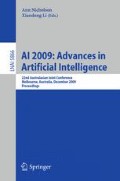Abstract
We present new techniques for relative SAT encoding of permutations with constraints, resulting in improved scalability compared to the previous approach by Prestwich, when applied to searching for Hamiltonian cycles. We observe that half of the ordering variables and two-thirds of the transitivity constraints can be eliminated. We exploit minimal enumeration of transitivity, based on 12 triangulation heuristics, and 11 heuristics for selecting the first node in the Hamiltonian cycle. We propose the use of inverse transitivity constraints. We achieve 3 orders of magnitude average speedup on satisfiable random graphs from the phase transition region, 2 orders of magnitude average speedup on unsatisfiable random graphs, and up to 4 orders of magnitude speedup on satisfiable structured graphs from the DIMACS graph coloring instances.
Access this chapter
Tax calculation will be finalised at checkout
Purchases are for personal use only
Preview
Unable to display preview. Download preview PDF.
References
Ansótegui, C., del Val, A., Dotú, I., Fernández, C., Manyà, F.: Modeling Choices in Quasigroup Completion: SAT vs. CSP. In: 19th National Conference on Artificial Intelligence, July 2004, pp. 137–142 (2004)
Cadoli, M., Schaerf, A.: Compiling Problem Specifications into SAT. Artificial Intelligence 162(1-2), 89–120 (2005)
Cheeseman, P., Kanefsky, B., Taylor, W.M.: Where the Really Hard Problems Are. In: 12th International Joint Conference on AI (IJCAI 1991), pp. 331–337 (1991)
de Kleer, J.: A Comparison of ATMS and CSP Techniques. In: 11th Int’l. Joint Conference on Artificial Intelligence (IJCAI 1989), August 1989, pp. 290–296 (1989)
DIMACS Graph Coloring Instances, http://mat.gsia.cmu.edu/COLOR/instances.html
Eén, N., Sörensson, N.: MiniSat—a SAT solver with conflict-clause minimization. In: Bacchus, F., Walsh, T. (eds.) SAT 2005. LNCS, vol. 3569. Springer, Heidelberg (2005)
Frank, J., Martel, C.U.: Phase Transitions in the Properties of Random Graphs. In: Principles and Practice of Constraint Programming, CP 1995 (1995)
Frank, J.: Personal Communication (April 2009)
Garey, M.R., Johnson, D.S.: Computers and Intractability: A Guide to the Theory of NP-Completeness. W. H. Freeman, New York (1979)
Goldberg, E., Novikov, Y.: BerkMin: A Fast and Robust Sat-Solver. In: Design, Automation, and Test in Europe (DATE 2002), March 2002, pp. 142–149 (2002)
Gomes, C.P., Shmoys, D.B.: The Promise of LP to Boost CSP Techniques for Combinatioral Problems. In: International Conference on Integration of AI and OR Techniques in Constraint Programming for Combinatorial Optimization Problems (CP-AI-OR 2002), March 2002, pp. 291–305 (2002)
Hnich, B., Walsh, T., Smith, B.M.: Dual Modelling of Permutation and Injection Problems. Journal of Artificial Intelligence Research (JAIR) 21, 357–391 (2004)
Hoos, H.H.: SAT-Encodings, Search Space Structure, and Local Search Performance. In: Int’l. Joint Conference on Artificial Intelligence (IJCAI 1999), August 1999, pp. 296–303 (1999)
Huang, J.: A Case for Simple SAT Solvers. In: Bessière, C. (ed.) CP 2007. LNCS, vol. 4741, pp. 839–846. Springer, Heidelberg (2007)
Iwama, K., Miyazaki, S.: SAT-Varible Complexity of Hard Combinatorial Problems. In: IFIP 13th World Computer Congress, August–September 1994, vol. (1), pp. 253–258 (1994)
Kautz, H.A., Ruan, Y., Achlioptas, D., Gomes, C.P., Selman, B., Stickel, M.E.: Balance and Filtering in Structured Satisfiable Problems. In: 17th Int’l. Joint Conference on Artificial Intelligence (August 2001)
Kautz, H.A., Selman, B.: The State of SAT. Discrete Applied Mathematics 155(12) (June 2007)
Kjaerulff, U.: Triangulation of Graphs—Algorithms Giving Small Total State Space. Technical Report R 90-09, Institute for Electronic Systems, Denmark (March 1990)
Moskewicz, M.W., Madigan, C.F., Zhao, Y., Zhang, L., Malik, S.: Chaff: Engineering an Efficient SAT Solver. In: 38th Design Automation Conference (DAC 2001) (June 2001)
Pipatsrisawat, K., Darwiche, A.: A New Clause Learning Scheme for Efficient Unsatisfiability Proofs. In: Twenty-Third AAAI Conference on Artificial Intelligence (AAAI 2008), July 2008, pp. 1481–1484 (2008)
Prestwich, S.D.: SAT Problems with Chains of Dependent Variables. Discrete Applied Mathematics 130(2), 329–350 (2003)
Rose, D.: Triangulated Graphs and the Elimination Process. Journal of Mathematical Analysis and Applications 32, 597–609 (1970)
Rose, D.: A Graph-Theoretic Study of the Numerical Solution of Sparse Positive Definite Systems of Linear Equations. In: Read, R.C. (ed.) Graph Theory and Computing, pp. 183–217. Academic Press, NY (1973)
Ryan, L.: Siege SAT Solver v.4, http://www.cs.sfu.ca/~loryan/personal/
Sato, N., Tinney, W.F.: Techniques for Exploiting the Sparsity or the Network Admittance Matrix. IEEE Transactions on Power Apparatus and Systems 82(69), 944–950 (1963)
Tinney, W.F., Walker, J.W.: Direct Solutions of Sparse Network Equations by Optimally Ordered Triangular Factorization. Proceedings of the IEEE 55(11), 1801–1809 (1967)
Vandegriend, B., Culberson, J.: The G n,m Phase Transition Is Not Hard for the Hamiltonian Cycle Problem. Journal of Artificial Intelligence Research (JAIR) 9, 219–245 (1998)
Velev, M.N., Gao, P.: Efficient SAT-Based Techniques for Design of Experiments by Using Static Variable Ordering. In: 10th International Symposium on Quality Electronic Design (ISQED 2009) (March 2009)
Velev, M.N., Gao, P.: Efficient SAT Techniques for Absolute Encoding of Permutation Problems: Application to Hamiltonian Cycles. In: 8th Symposium on Abstraction, Reformulation and Approximation (2009)
Yanakakis, M.: Computing the Minimum Fill-in Is NP-Complete. SIAM Journal of Algebraic and Discrete Mathematics 2, 77–79 (1981)
Author information
Authors and Affiliations
Editor information
Editors and Affiliations
Rights and permissions
Copyright information
© 2009 Springer-Verlag Berlin Heidelberg
About this paper
Cite this paper
Velev, M.N., Gao, P. (2009). Efficient SAT Techniques for Relative Encoding of Permutations with Constraints. In: Nicholson, A., Li, X. (eds) AI 2009: Advances in Artificial Intelligence. AI 2009. Lecture Notes in Computer Science(), vol 5866. Springer, Berlin, Heidelberg. https://doi.org/10.1007/978-3-642-10439-8_52
Download citation
DOI: https://doi.org/10.1007/978-3-642-10439-8_52
Publisher Name: Springer, Berlin, Heidelberg
Print ISBN: 978-3-642-10438-1
Online ISBN: 978-3-642-10439-8
eBook Packages: Computer ScienceComputer Science (R0)

